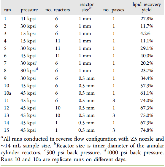Recovery of Fuel-Precursor Lipids from Oleaginous Yeast
- National Renewable Energy Lab. (NREL), Golden, CO (United States)
Bio-derived lipids offer a potentially promising intermediate to displace petroleum-derived diesel. One of the key challenges for the production of lipids via microbial cell mass is that these products are stored intracellularly and must be extracted and recovered efficiently and economically. Thus, improved methods of cell lysis and lipid extraction are needed. In this study, we examine lipid extraction from wet oleaginous yeast in combination with seven different cell lysis approaches encompassing both physical and chemical techniques (high-pressure homogenization, microwave and conventional thermal treatments, bead beating, acid, base, and enzymatic treatments) to facilitate lipid extraction from a model oleaginous yeast strain, Lipomyces starkeyi. Of the seven techniques investigated, acid treatment led to the highest lipid recovery yields. Further exploration of acid treatment and integration with an economic model revealed that treatment at 170 degrees C for 60 min at 1 wt% H2SO4 and 8 wt% yeast solids represents a viable option for both lipid recovery yield and process economics, enabling experimental lipid recovery yields of 88.5-93.0% to be achieved at a corresponding estimated minimum fuel selling price (MFSP) of $5.13-$5.61/gallon of gasoline equivalent (GGE). The same acid treatment conditions applied to two other strains of oleaginous yeast (Cutaneotrichosporon curvatus and Rhodotorula toruloides) resulted in similar lipid recovery yields. In pretreatment experiments scaled up to 300 mL, slightly lower temperatures or shorter pretreatment times, along with higher yeast solids loading, resulted in higher lipid yields than the conditions identified from the small-scale runs. Two replicate runs carried out at 170 degrees C for 30 min using 1 wt% H2SO4 and 19 wt% yeast solids achieved an average lipid recovery of 96.1% at a corresponding estimated MFSP of $4.89/GGE. In all cases, the lipids are primarily triglycerides and free fatty acids comprised mainly of palmitic, stearic, and oleic acids, with smaller fractions of polar lipids. The fatty acid composition of the lipids extracted from the wet treated cell mass is the same as that in freeze-dried whole oleaginous yeast cell mass, suggesting the acid treatment renders all lipids extractable. This work demonstrates that acid treatment is a robust and effective cell lysis technique in a microbial lipid-based biofuel scenario and provides a baseline for further scale-up and process integration.
- Research Organization:
- National Renewable Energy Laboratory (NREL), Golden, CO (United States)
- Sponsoring Organization:
- USDOE Office of Energy Efficiency and Renewable Energy (EERE), Sustainable Transportation Office. Bioenergy Technologies Office (BETO)
- Grant/Contract Number:
- AC36-08GO28308
- OSTI ID:
- 1422871
- Report Number(s):
- NREL/JA-5100-70832
- Journal Information:
- ACS Sustainable Chemistry & Engineering, Vol. 6, Issue 3; ISSN 2168-0485
- Publisher:
- American Chemical Society (ACS)Copyright Statement
- Country of Publication:
- United States
- Language:
- English
Web of Science
Integrated diesel production from lignocellulosic sugars via oleaginous yeast
|
journal | January 2018 |
Simultaneous lipid biosynthesis and recovery for oleaginous yeast Yarrowia lipolytica
|
journal | October 2019 |
Similar Records
Fatty alcohol production in Lipomyces starkeyi and Yarrowia lipolytica
Conceptual Basis and Techno-Economic Modeling for Integrated Algal Biorefinery Conversion of Microalgae to Fuels and Products (2019 NREL TEA Update: Highlighting Paths to Future Cost Goals via a New Pathway for Combined Algal Processing)











